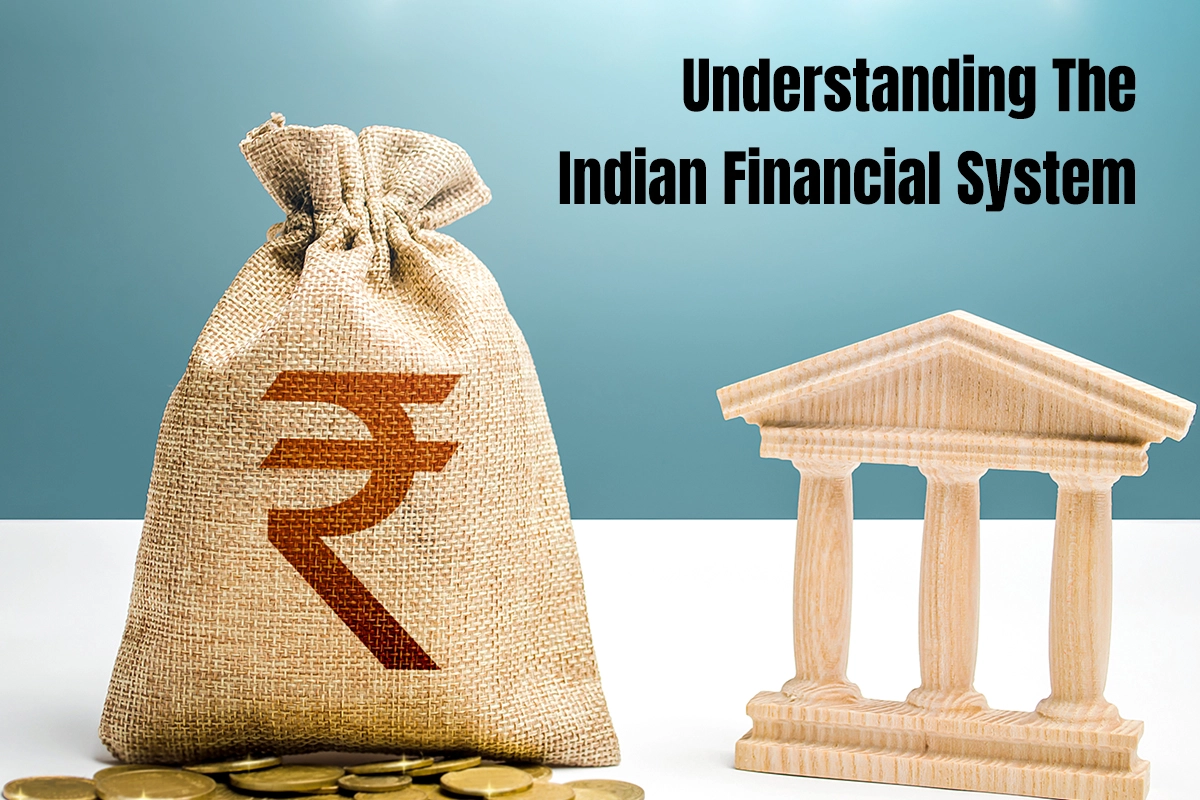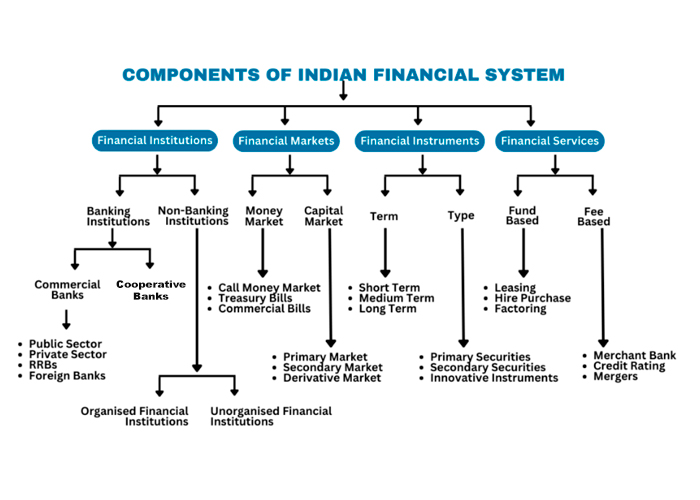
- Finance
- August 1, 2024
Understanding the Indian Financial System
Ever since ancient times, every nation has required an effective financial system. It is responsible for maintaining the economic stability that is needed to run a country. Only if the financial system functions well will a country thrive. If this system breaks down, the living conditions will become unstable.
You may ask, what is the benefit of having a strong financial system?
Let’s discuss a few of them to provide you with a general overview.
- It provides better opportunities and fosters development.
- When finances are stable, people can find better occupations and enjoy higher standards of living.
- It guarantees citizens the chance to grow and make investments.
- People earn sufficient income, and inflation remains moderate.
So, all in all, a solid financial system makes all of these things possible. The structure of the Indian financial system is crucial to understand, as it is the foundation upon which the entire nation’s economy rests. Therefore, this blog will decode the Indian financial system.
Indian Financial System – An Overview
The Indian financial system is very important for the growth and stability of our economy. This system manages the flow of funds between the people (household savings) of the country and the ones who may invest it wisely (investors/businessmen) for the betterment of both parties.
The services that are provided to a person by the various financial institutions, including banks, insurance companies, pensions, funds, etc., constitute the financial system. Given below are the features of the Indian financial system:
- It plays a vital role in the economic development of the country, as it encourages both savings and investment.
- It helps in mobilising and allocating one’s savings.
- It facilitates the expansion of financial institutions and markets.
- Plays a key role in capital formation.
- It helps form a link between the investor and the one saving.
- It is also concerned with the provision of funds.
The financial system of a country mainly aims at managing and governing the mechanisms of production, distribution, exchange, and holding of financial assets or instruments of all kinds.
In subsequent sections of this article, we will examine the different elements of the Indian financial system.
Components of the Indian Financial System
There are four main components of the Indian financial system. This includes:
- Financial Institutions
- Financial Assets
- Financial Services
- Financial Markets
Let’s discuss each component of the system in detail.

Financial Institutions
The structure of financial institutions acts as a mediator between the investor and the borrower. The investor’s savings are mobilised either directly or indirectly via the financial markets.
The main functions of the financial institutions are as follows:
- A short-term liability can be converted into a long-term investment.
- It helps in the conversion of a risky investment into a risk-free investment.
- It also acts as a medium of convenience, which means it can match a small deposit with large loans and a large deposit with small loans.
The best example of a financial institution is a bank. People with surplus amounts of money make savings in their accounts, and people in dire need of money take out loans. The bank acts as an intermediary between the two.
The financial institutions can further be divided into two types:
Banking Institutions or Depository Institutions: This includes banks and other credit unions that collect money from the public against interest provided on the deposits made and lend that money to those in need.
Non-Banking Institutions or Non-Depository Institutions: Insurance, mutual funds, and brokerage companies fall under this category. They cannot ask for monetary deposits but sell financial products to their customers.
Further, financial institutions can be classified into three categories:
Regulatory: Institutes that regulate the financial markets, like the RBI, IRDA, SEBI, etc.
Intermediates: Commercial banks that provide loans and other financial assistance, such as SBI, BOB, PNB, etc.
Non-Intermediates: Institutions that provide financial aid to corporate customers. It includes NABARD, SIBDI, etc.
Financial Assets
The products that are traded in the financial markets are called financial assets. Based on the different requirements and needs of the credit seeker, the securities in the market also differ from each other.
Some important financial assets have been discussed briefly below:
Call Money: When a loan is granted for one day and is repaid on the second day, it is called call money. No collateral securities are required for this kind of transaction.
Notice Money: When a loan is granted for more than a day and for less than 14 days, it is called notice money. No collateral securities are required for this kind of transaction.
Term Money: When the maturity period of a deposit is beyond 14 days, it is called term money.
Treasury Bills: Also known as T-Bills, these are government bonds or debt securities with a maturity of less than a year. Buying a T-Bill means lending money to the government.
Certificate of Deposits: It is a dematerialised form (electronically generated) for funds deposited in the bank for a specific period.
Commercial Paper: It is an unsecured short-term debt instrument issued by corporations.
Financial Services
Financial services are services provided by asset management and liability management companies. They help to get the required funds and make sure that they are efficiently invested.
The financial services in India include:
Banking Services: Any small or big service provided by banks, like granting a loan, depositing money, issuing debit/credit cards, opening accounts, etc.
Insurance Services: Services like the issuing of insurance, selling policies, insurance undertakings, brokerages, etc. are all part of the insurance services.
Investment Services: It mostly includes asset management.
Foreign Exchange Services: Exchange of currency, foreign exchange, etc. are part of the foreign exchange services.
The main aim of financial services is to assist a person with selling, borrowing, or purchasing securities, allowing payments and settlements; and lending and investing.
Financial Markets
The marketplace where buyers and sellers interact with each other and participate in the trading of money, bonds, shares, and other assets is called a financial market.
The financial market can be further divided into four types:
Capital Market: Designed to finance long term investment, the capital market deals with transactions that have been taking place in the market for over a year. The capital market can further be divided into three types:
- Corporate Securities Market
- Government Securities Market
- Long-Term Loan Market
Money Market: Mostly dominated by the government, banks, and other large institutions, this type of market is authorised for small-term investments only. It is a wholesale debt market that works on low-risk and highly liquid instruments. The money market can further be divided into two types:
- Organised Money Market
- Unorganised Money Market
Foreign exchange Market: One of the most developed markets across the world, the foreign exchange market, deals with the requirements related to multi-currencies. The transfer of funds in this market takes place based on the foreign currency rate.
Credit Market: A market where short-term and long-term loans are granted to individuals or Organisations by various banks and financial and non-financial institutions is called a credit market.
Conclusion
The Indian financial system is a complex yet essential part of our economy. Its various components – financial institutions, assets, services, and markets – work in tandem to mobilize savings, allocate resources, and facilitate economic growth. As India continues its path of development, a robust and adaptive financial system will be crucial in supporting the nation’s economic ambitions and improving the financial well-being of its citizens.
The importance of finance cannot be overstated in this context. Understanding this system is key for individuals and businesses alike, as it impacts everything from personal savings to large-scale investments. By continually refining and strengthening our financial system, India can build a more prosperous and financially inclusive future for all.
RELATED POSTS

- Finance
- September 30, 2024

- Finance
- September 26, 2024

- Finance
- September 23, 2024











